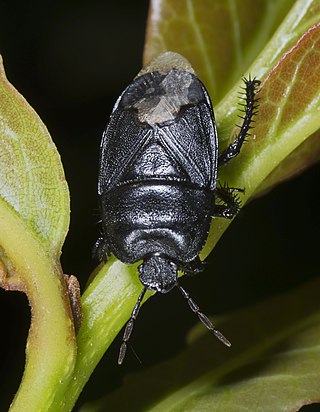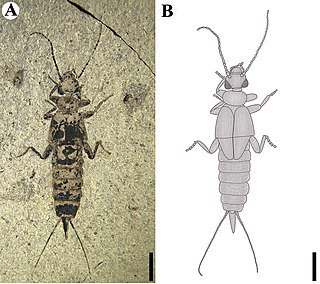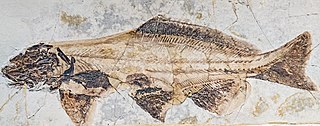
The Cupedidae are a small family of beetles, notable for the square pattern of "windows" on their elytra, which give the family their common name of reticulated beetles.

The Trachypachidae are a family of beetles that generally resemble small ground beetles, but that are distinguished by the large coxae of their rearmost legs. There are only six known extant species in the family, with four species of Trachypachus found in northern Eurasia and northern North America, and two species of Systolosoma in Chile and Argentina. They were much more diverse in the past, with dozens of described species from the Mesozoic.

Cydnidae are a family of pentatomoid bugs, known by common names including burrowing bugs or burrower bugs. As the common name would suggest, many members of the group live a subterranean lifestyle, burrowing into soil using their head and forelegs, only emerging to mate and then laying their eggs in soil. Other members of the group are not burrowers, and live above the soil layer, often in close association with plants. Several species are known as agricultural pests.

Taeniopterygidae are a family of stone flies with about 110 described extant species. They are commonly called willowflies or winter stoneflies and have a holarctic distribution. Adults are usually smaller than 15 mm.

Nemonychidae is a small family of weevils, placed within the primitive weevil group because they have straight rather than geniculate (elbowed) antennae. They are often called pine flower weevils. As in the Anthribidae, the labrum appears as a separate segment to the clypeus, and the maxillary palps are long and projecting. Nemonychidae have all ventrites free, while Anthribidae have ventrites 1-4 connate or partially fused. Nemonychidae lack lateral carinae on the pronotum, while these are usually present, though may be short, in Anthribidae.

The Perissommatidae are a family of flies (Diptera) that was proposed in 1962 by Donald Colless based on the species Perissomma fusca from Australia. The family now includes five extant species within the single genus Perissomma, four from Australia and one from Chile. The Perissommatidae are unusual as they appear to have four compound eyes. They have a small slender body less than 2 mm in length. Their wings are large in comparison to their bodies and subsequently their flight is weak. Preferring high-altitude forest environments, adults only fly in the winter. The larvae live in decaying leaf litter in wet sclerophyll or cool rain forests. Some species are suspected to be associated with fungi. In the case of Perissomma macalpinei, numbers of adults have been observed congregating in clumps of foliage and rising in short, zigzag flights in the sunlight above the foliage for short periods before descending.

Protodiplatyidae is an extinct family of earwigs. It is one of three families in the suborder Archidermaptera, alongside Dermapteridae and Turanovia. Species are known from Jurassic and Early Cretaceous fossils and have unsegmented cerci and tarsi with four to five segments.

Coptoclavidae is an extinct family of aquatic beetles in the suborder Adephaga. The Coptoclavidae lived from the Late Triassic to the Early Cretaceous. Coptoclavidae is a member of the adephagan clade Dytiscoidea, which contains other aquatic beetles. Suggested reasons for their extinction to include the rise of teleost fish, or competition with Gyrinidae and Dytiscidae, which possess defensive secretions and sucking channels in the mandibles of larvae, which coptoclavids likely lacked. It has been suggested that the genus Timarchopsis and the subfamily Timarchopsinae are only distantly related to other coptoclavids based on cladistic analysis, with Timarchopsis being more closely related to geadephagans like carabids and trachypachids instead. Another study also suggested similarly for Coptoclavisca and possibly other coptoclaviscines.
Protorabinae is an extinct subfamily of beetles in the family Carabidae. It contains 36 species in 13 genera, all extinct.
Angarogyrus is an extinct genus of fossil beetles in the family Gyrinidae, containing the following species:

Tetraphalerus is a genus of beetles in the family Ommatidae, It is currently known from two extant species native to South America and several fossil species from the Jurassic and Cretaceous of Asia.

Mesoraphidiidae is an extinct family of snakeflies in the suborder Raphidiomorpha. The family lived from the Late Jurassic through the Late Cretaceous and is known from twenty-five genera. Mesoraphidiids have been found as both compression fossils and as inclusions in amber. The family was first proposed in 1925 by the Russian paleoentomologist Andrey Vasilyevich Martynov based on Upper Jurassic fossils recovered in Kazakhstan. The family was expanded in 2002 by the synonymizing of several other proposed snakefly families. The family was divided into three subfamilies and one tribe in a 2011 paper, further clarifying the relationships of the included genera.

Chresmoda is an extinct genus of insects within the family Chresmodidae.

Heloridae is a family of wasps in the order Hymenoptera known primarily from fossils, and only one extant genus, Helorus, with 12 species found worldwide. Members of Helorus are parasitic on green lacewings.
The Progonocimicidae are an extinct family of true bugs in the suborder Coleorrhyncha. Progonocimicidae fossils have been found in Europe, Asia, Australia, and South America.
Liberiblattinidae is an extinct family of cockroaches known from the Jurassic to Cretaceous. Some taxa, like Cryptoblatta and Hydrokhoohydra, are suggested to be semiaquatic. Spongistoma is suggested to be a nectarivore due to its unique sucking/sponging "proboscis" mouthparts. Some authors have suggested that the family is ancestral to Mantodea.

Eremochaetidae is an extinct family of brachyceran flies known from the Jurassic and Cretaceous periods of Asia. It is part of the extinct superfamily Archisargoidea. The morphology of the ovipositor of the only 3 dimensionally preserved genus Zhenia was initially interpreted as evidence of being an endoparasitoid of arthropods, however a subsequent study suggested that the ovipositor was used to deposit its eggs in plant material, similar to members of Tephritoidea. In a phylogenetic analysis, Ermochaetidae was found to be monophyletic, surrounded by a paraphyletic Archisargidae.

Elcanidae are an extinct family of Mesozoic and early Cenozoic orthopterans. Members of the family are distinguished by the presence of spurs on the distal part of the metatibia, unique among orthopterans, these have been suggested to have been used for controlling gliding, swimming aids, or for jumping on water. The group combines characteristics from both major groups of orthopterans, with long antennae and nymphal morphology similar to Ensifera, but with wing venation and adult morphology more similar to Caelifera. Elcanidae is part of Elcanoidea, which is thought to have diverged from living orthopterans by the beginning of the Permian, around 300 million years ago. The family also includes Permelcanidae, known from the Early-Late Permian. The relationship of Elcanoidea to Ensifera and Caelifera is currently unresolved. Elcanids are known from the Late Triassic to Paleocene of Eurasia, North and South America. Some members of the group exhibited aposematic coloration.
Angarosphecidae is an extinct family of Mesozoic and early Cenozoic wasps in the superfamily Apoidea.

Peipiaosteidae is an extinct family of fish, known from the Late Jurassic and Early Cretaceous of Asia. They are members of Acipenseriformes, related to sturgeons (Acipenseridae) and paddlefish (Polyodontidae). Fossils have been found in freshwater deposits in China, Russia, Kazakhstan, and Mongolia. They are generally considered either the earliest diverging group of Acipenseriformes, or the sister group to the clade containing Acipenseridae and Polyodontidae. At least Yanosteus was likely to have been piscivorous, based on a specimen of Lycoptera found in the mouth of one specimen.














